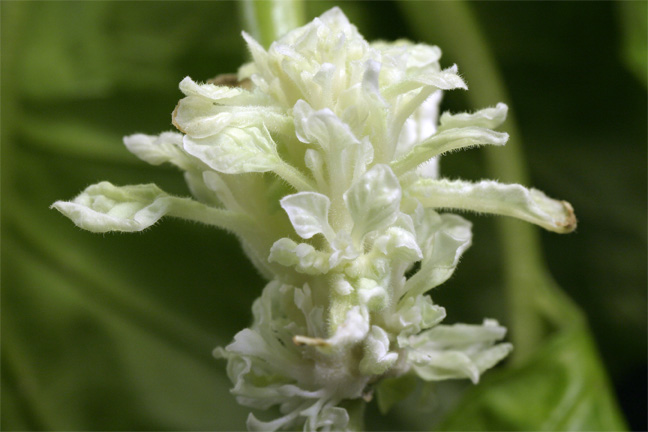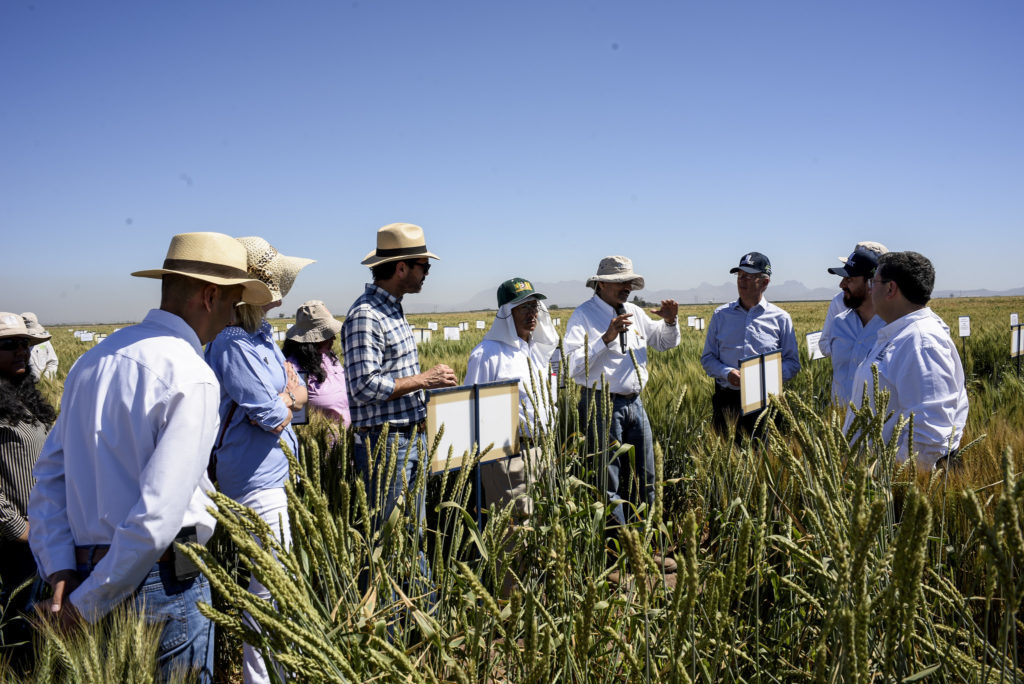






By Mathew Reynolds, Wheat Physiologist at, CIMMYT
First post of our “Global Collaboration” series
Wheat is the most widely grown crop in the world, currently providing about 20 percent of human calorie consumption. However, demand is predicted to increase by 60 percent within just 30 years, while long-term climate trends threaten to reduce wheat productivity, especially in less developed countries.
For over half a century, the International Wheat Improvement Network (IWIN), coordinated by CIMMYT, has been a global leader in breeding and disseminating improved wheat varieties to combat this problem, with a major focus on the constraints of resource poor farmers.

Two complementary networks — the Heat and Drought Wheat Improvement Consortium (HeDWIC) and the International Wheat Yield Partnership (IWYP) — are helping to meet the future demand for wheat consumption through global collaboration and technological partnership.
By harnessing the latest technologies in crop physiology, genetics and breeding, network researchers support the development of new varieties that aim to be more climate resilient, in the case of HeDWIC and with higher yield potential, in the case of IWYP.
These novel approaches to collaboration take wheat research from the theoretical to the practical and incorporate science into real-life breeding scenarios. Methods such as screening genetic resources for physiological traits related to radiation use efficiency and identifying common genetic bases for heat and drought adaptation are leading to more precise breeding strategies and more data for models of genotype-by-environment interaction that help build new plant types and experimental environments for future climates.
IWYP addresses the challenge of raising the genetic wheat yield potential of wheat by up to 50 percent in the next two decades. Achieving this goal requires a strategic and collaborative approach to enable the best scientific teams from across the globe to work together in an integrated program. TheIWYP model of collaboration fosters linkages between ongoing research platforms to develop a cohesive portfolio of activities that maximizes the probability of impact in farmers’ fields IWYP research uses genomic selection to complement the crossing of complex traits by identifying favorable allele combinations among progeny. The resulting products are delivered to national wheat programs worldwide through the IWIN international nursery system.
Recently, IWYP research achieved genetic gains through the strategic crossing of biomass and harvest index — source and sink — an approach that also validates the feasibility of incorporating exotic germplasm into mainstream breeding efforts.
In the case of HeDWIC, intensified — and possibly new — breeding strategies are needed to improve the yield potential of wheat in hotter and drier environments. This also requires a combined effort, using genetic diversity with physiological and molecular breeding and bioinformatic technologies, along with the adoption of improved agronomic practices by farmers. The approach already has proof of concept in the release and adoption of three heat and drought tolerant lines in Pakistan.
It is imperative to build increased yield and climate-resilience to into future germplasm in order to avoid the risk of climate-related crop failure and to maintain global food security in a warmer climate. Partnerships like HeDWIC and IWYP give hope to meeting this urgent food security challenge.
Further readings:
https://www.hedwic.org/resources.htm
https://royalsocietypublishing.org/doi/full/10.1098/rspb.2012.2190
An economist’s perspective on plant sciences: Under-appreciated, over-regulated and under-funded
This week we spoke to Francisco Gomez and Ammani Kyanam, graduate students in the Soil and Crop Science Department at Texas A&M University, USA. They were part of the organizing committee for the recent Texas A&M Plant Breeding Symposium, a successful meeting run entirely by students at the University.

Francisco Gomez and Ammani Kyanam, part of the student organizing committee of the Plant Breeding Symposium
Could you begin with a brief introduction to the Plant Breeding Symposium held at Texas A&M in February?
Texas A&M University is one of the largest academic and public plant breeding institutions worldwide, which trains breeders in a variety of programs. Every year, students at the University organize the Texas A&M Plant Breeding Symposium, which is part of the DuPont Pioneer series of symposia. The symposium provides a platform for graduate students to bridge the interaction between the public and private sectors and engage in conversations about the grand challenges facing humanity that could be addressed by plant breeding. It’s also a great chance to network with faculty, students, and industry representatives.
Could you tell us more about this theme and how the different sessions were chosen?
We wanted the theme of the meeting to mirror the university’s goal of thinking big to pinpoint solutions to modern global challenges using plant science and breeding. Every member of the committee had the opportunity propose a theme, which were then put to a vote.

Nikolai Vavilov, a Russian botanist and geneticist, was the inspiration for this year’s symposium. Image credit: Public Domain.
This year’s theme, “The Vavilov Method: Utilizing Genetic Diversity”, celebrated the life and career of Russian botanist Nikolai Vavilov, who identified the centers of origin of cultivated plants. We invited plant scientists and breeders who are applying Vavilov’s ideas through the conservation, collection, and effective utilization of genetic diversity in modern crop breeding programs. This year we also developed a workshop entitled “Where does a breeder go to find genetic diversity?”, which allowed students and faculty to talk about the importance of utilizing genetic diversity in crop improvement and to learn new tools to help them incorporate genetic diversity in breeding programs.
Could you tell us more about how you developed the workshop?
Our aim for the workshop was to engage students and faculty on where we can find genetic diversity, how we can use it, and to include a panel discussion on the challenges and the future of genetic diversity in modern plant breeding programs. As a new value-added event, the workshop was challenging to set up because it required a different set of skills to the rest of the meeting. Once we had an idea of what we wanted, we set up an initial meeting with our speakers where we brainstormed ideas. After several online meetings and e-mails with Professor Paul Gepts (UC Davis), Dr. Colin Khoury (Agricultural Research Service, USDA; check out his recent GPC blog here!), and Professor Susan McCouch (Cornell University), we finalized the structure of the workshop, the layout of the sessions, and the objectives for the speakers. We also had a representative from DivSeek, Dr. Ruth Bastow, on the discussion panel, who contributed to our discussion on future tools for accessing diversity in the future.
How has the symposium grown since the inaugural meeting in 2015?
Every year we want to make the symposium a memorable event, and we want other students and faculty to really get something out of it. We are learning more and more about the students and faculty with these events, particularly in terms of which topics are the most exciting or interesting. The symposium has also grown into a two-day event, with this year’s inclusion of the workshop.
Did you have to overcome any challenges in the organization of the event?
One of our biggest challenges was to secure funding for the event, which is free to attend. To add further value to our event, we wanted to have additional components such as a student research competition and/or workshop, which meant we had to aggressively fundraise from multiple sources. This involved writing a lot of grant proposals both to plant sciences departments across Texas A&M University, as well as to other sources of external funding.
We are grateful to DuPont Pioneer for providing a large amount of the funding. In 2017, we also received sponsorship from the Texas Institute for Genomic Science and Society, Departments of Soil and Crop Sciences, Molecular and Environmental Plant Science, Horticulture, Plant Pathology, and Biology, Texas Grain Sorghum Association, Texas Peanut Producers Board, and Cotton Incorporated. Our beverage sponsor was Pepsi and Kind Snacks was our snack sponsor.
What advice would you give a graduate student trying to organize a similar event?
Plan early and set small goals! Communication is key for a large team to organize such an event. We encourage groups to use Slack or some sort of team work interface. It really helped us to be in constant communication with each other during the months leading up to the symposium.
Could you tell us a little about your own research?
My research (Francisco Gomez) is focused on identifying genomic regions (known as quantitative trait loci; QTLs) associated with mechanical traits that are known to be associated with stem lodging, a major agronomic problem that reduces yields worldwide. My colleague and co-chair, Ammani Kyanam, received her Masters in Plant Breeding in while working in the cotton cytogenetics program in our department. Her research focused on developing genomic tools to facilitate the development of Chromosome Segment Substitution Lines for upland cotton. She is currently mapping QTLs for aphid resistance in sorghum for her Ph.D. You can learn more about the research of our individual committee members at http://plantbreedingsymposium.com/committee/.
How can our readers connect with you?
We have a strong social media presence via Facebook, Instagram and YouTube, where we post event videos, photos and periodical updates. Check them out below!
Facebook: TAMUPBsymposium
Instagram: @pbsymposium
Twitter: @pbsymposium
YouTube: Texas A&M Plant Breeding Symposium
Website: plantbreedingsymposium.com
Email: mailto:pbsymposium@gmail.com
New Breeding Technologies in the Plant Sciences – Applications and Implications in Genome Editing
Gothenburg, Sweden, 7-8th July 2017
REGISTRATION FOR THIS MEETING IS NOW OPEN!
Organised by: Dr Ruth Bastow (Global Plant Council), Dr Geraint Parry (GARNet), Professor Stefan Jansson (Umeå University, Sweden) and Professor Barry Pogson (Australian National University, Australia).
Targeted genome engineering has been described as a “game-changing technology” for fields as diverse as human genetics and plant biotechnology. Novel techniques such as CRISPR-Cas9, Science’s 2015 Breakthrough of the Year, are revolutionizing scientific research, allowing the targeted and precise editing of genomes in ways that were not previously possible.
Used alongside other tools and strategies, gene-editing technologies have the potential to help combat food and nutritional insecurity and assist in the transition to more sustainable food production systems. The application and use of these technologies is therefore a hot topic for a wide range of stakeholders including scientists, funders, regulators, policy makers and the public. Despite its potential, there are a number of challenges in the adoption and uptake of genome editing, which we propose to highlight during this SEB satellite meeting.
One of the challenges that scientists face in applying technologies such as CRISPR-Cas9 to their research is the technique itself. Although the theoretical framework for using these techniques is easy to follow, the reality is often not so simple. This meeting will therefore explain the principles of applying CRISPR-Cas9 from experts who have successfully used this system in a variety of plant species. We will explore the challenges they encountered as well as some of the solutions and systems they adopted to achieve stably transformed gene-edited plants.
The second challenge for these transformative technologies is how regulatory bodies will treat and asses them. In many countries gene editing technologies do not fit within current policies and guidelines regarding the genetic modification and breeding of plants, as it possible to generate phenotypic variation that is indistinguishable from that generated by traditional breeding methods. Dealing with the ambiguities that techniques such as CRISPR-Cas9 have generated will be critical for the uptake and future use of new breeding technologies. This workshop will therefore outline the current regulatory environment in Europe surrounding gene editing, as well as the approaches being taken in other countries, and will discuss the potential implications and impacts of the use of genome engineering for crop improvement.
Overall this meeting will be of great interest to plant and crop scientists who are invested in the future of gene editing both on a practical and regulatory level. We will provide a forum for debate around the broader policy issues whilst include opportunities for in-depth discussion regarding the techniques required to make this technology work in your own research.
This meeting is being held as a satellite event to the Society for Experimental Biology’s Annual Main Meeting, which takes place in Gothenburg, Sweden, from the 3–6th July 2017.